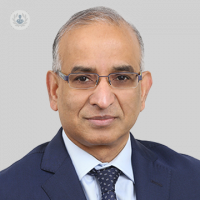An in-depth discussion about knee replacement: part 1
Written by:Knee replacement is one of the most common procedures that orthopaedic surgeons perform each year. Consultant trauma and orthopaedic surgeon Mr Tarique Parwez discusses the procedure in depth.
How do you choose between a traditional knee replacement and a minimally invasive knee replacement and what are the advantages and disadvantages of each approach?
In the past, minimally invasive knee replacement was very popular and it is still being performed by some doctors in the present day.
The idea was that it would lead to faster recovery, a reduced hospital stay and fewer complications. However, due to the advancement of the enhanced recovery system and better anaesthesia, even with traditional surgical approaches where we have to cut the tendons and inward the knee joint, patients are going home after a one or two-night stay.

Overall, the incidence of minimally invasive knee surgery advantages have gone down significantly. As previously mentioned, the advantage was less tissue trauma and faster recovery. The downside is that nowadays we have to give powerful anti-clot medications.
With the minimally invasive approach, there was a lot of bruising just underneath the skin, which would drag down the leg and most patients used to hit it and it was quite unnerving for the patients.
I used to perform MIS regularly, and about 10 to 20% of patients would have mild bruising on the knee.
With the advent of better energy and enhanced recovery with the traditional approach there's no bruising under the skin, it's much more tolerated and visually more appealing to the patient. They're less scared of having a total knee replacement.
I now have gone back to the traditional surgery methos. Occasionally I still do the minimally invasive approach where I feel that the quadriceps or the muscles are quite weak and I don't want to violate that.
One of the advantages was that patients were able to lift the leg and mobilise much quicker. However, if the patient is quite weak, then I still do the MIS approach.
9 out of 10 cases of mine are done with the traditional approach where we have to cut the tendon, cut the minimal amount.
How do you assess a patient's risk factors for complications during knee replacement surgery?
The complications can be divided into surgeon factors, patient factors and environmental factors.
Surgeon factors
As surgeons, we have to do surgery in an ultra clean environment with ultra clean instruments. The surgeon has to be aware of each level where it can cause infection or complications and the surgical site infection leads. We go through 30 or 40 steps before an operation, during the operation, and after the operation to minimise the risk of infection.
Patient and environmental factors
There are certain patient factors which we need to be aware of, which can increase the risk of infection, such as diabetes, and renal disease, as well as other factors like being on medication which causes a patient to be immunocompromised.
We also need to take into account their past history, which includes social factors such as drinking and smoking history.
Smoking can lead to detrimental healing and if they have an infection or if the surgery is being done for something like primary osteoarthritis, rheumatoid arthritis, traumatic arthritis or any previous infection in that knee, smoking will increase the risk of complications.
The patient’s activity levels may be linked to complications. For example, a person who likes mountain biking or mountain climbing and increasingly does these activities, will wear their knee out early.
Patient expectations
It is important to advise patients on what a total knee replacement and artificial knee can achieve in terms of pain relief and how much residual pain they have. Some patients may have unrealistic expectations and become dissatisfied with results.
We try to get their expectations to a normal level when we meet them first. Despite the patient’s medical issue, we try to mitigate and minimise the complications.
In some cases, there are patients who have a previous history or family history of clots forming in the leg. In those conditions, we have to give them more powerful drugs to prevent clots, which may result in more bruising and bleeding inside the knee and may lead to more stiffness.
We try to minimise risk as much as possible. Even with all those things, sometimes a risk for a general person is 1 in 100. In those circumstances, it becomes 3 in 100. However, this still means that there is a 97% chance of success.
If you are considering having knee replacement surgery and would like to make an appointment with Mr Parwez, do not hesitate to do so by visiting his Top Doctors profile today.


